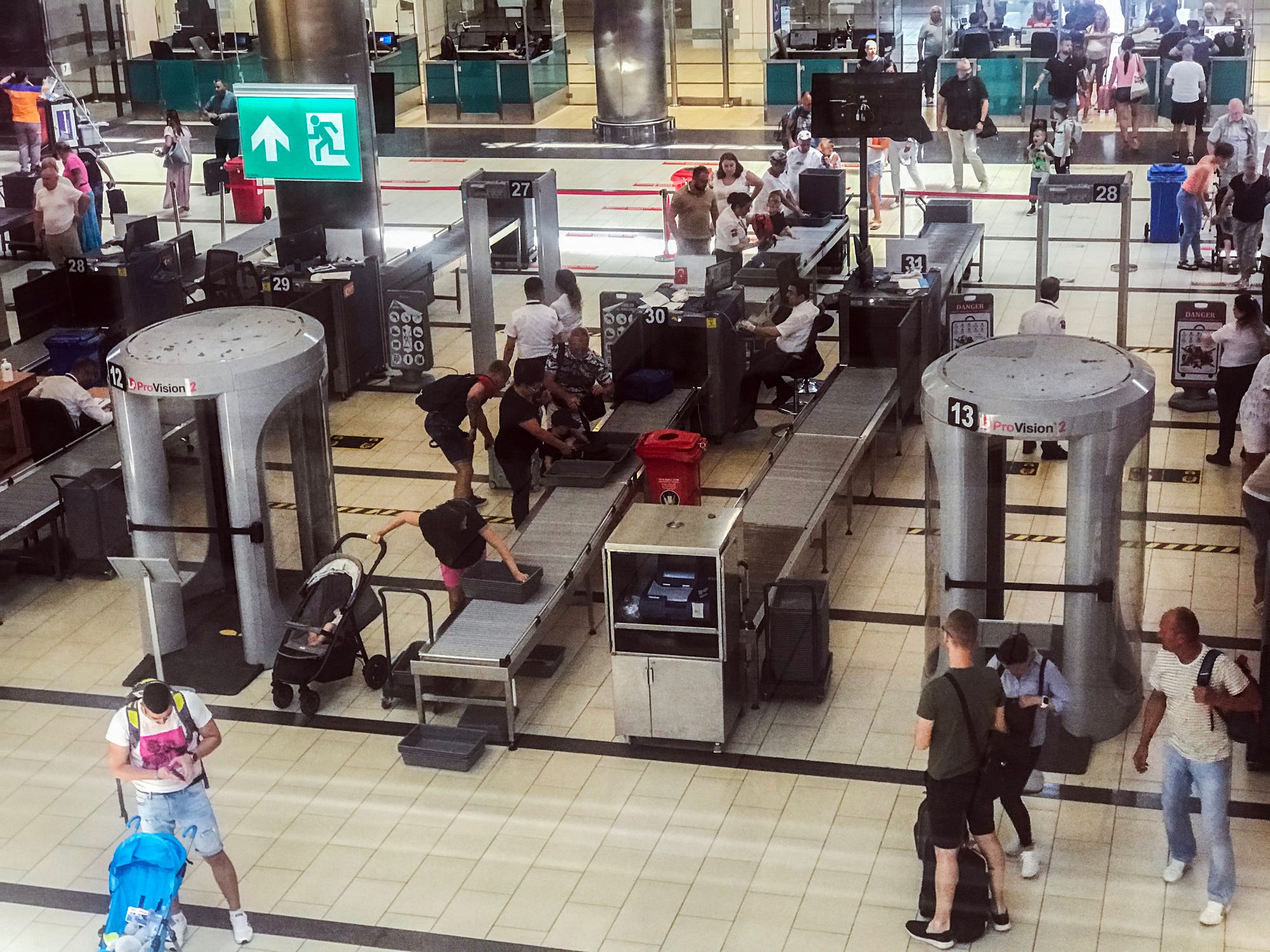|
 |
Alarmism About Terrorism Is Risky and Unjustified
The U.S. ought to be more realistic about the foreign-born terrorist threat
In their recent Foreign Affairs article “The Terrorism Warning Lights Are Blinking Red Again,” Harvard professor Graham Allison and former acting CIA director Michael J. Morell (henceforth A&M) argue that signs of imminent terrorist attacks on the U.S. are as strong now as when CIA director George Tenet warned about them before the 9/11 attacks. “Given the stakes, complacency is a greater risk than alarmism,” A&M reason. “Simply put,” they claim, “the United States faces a serious threat of a terrorist attack in the months ahead.”
A&M paint an ominous picture, but a reasonable level of concern is better than alarmism or complacency. Attacks on U.S. soil committed by terrorists who crossed the southern border are a possibility, but the wisest options are not to do nothing or to panic. There is an entire spectrum of concern between those routes that policymakers and the public should embrace. Terrorism is uncommon and difficult-to-impossible to predict, and—with some dramatic exceptions—it inflicts small amounts of damage the overwhelming majority of the time.
We agree with A&M when they argue that “assessments of national security threats must account for both the level of risk and the scale of potential consequences.” But we disagree with their conclusion that “in the case of terrorism, both should compel the administration to take action.” Their conclusion results from an incomplete assessment of the risks and costs of terrorism emanating from across the southern border and a disregard for the costs of alarmism—financial or otherwise. To recap the past 20-plus years, hysteria over terrorism resulted in violations of civil liberties, ethnic profiling, multiple foreign invasions, trillions of dollars spent on counterterrorism and trillions more in wealth generation forgone from increased restrictions on immigration in response to the alarmism to which A&M are asking us to return. To devise the smartest approach to limiting the foreign-born terrorist threat, we must ensure we’re getting the most accurate picture of this risk that we possibly can.
A Minuscule Possibility
Understanding the base rate of foreign-born terrorism in the United States is the best starting point for calculating that risk, but A&M totally neglect the base rate. Also known as a prior probability, the base rate is how common an event is within a certain dataset before taking any new information into account. Analysts need a base rate as a starting point to understanding how likely terrorism is, which they can then adjust with new evidence.
The base rate of foreign-born terrorism is startlingly low in the United States. From 1975 through the end of 2023, 230 foreign-born terrorists murdered 3,046 people in attacks on U.S. soil. About 98% of those deaths were the result of the 9/11 attacks—an outlier 213 times as deadly as the next deadliest foreign-born attack. Accordingly, the annual chance of being murdered in an attack committed by a foreign-born terrorist is about one in 4.5 million—about 323 times lower than the chance of being murdered in a normal homicide during that 1975-2023 timeframe.
Starting the analysis on January 1, 2002—including the first full year of a post-9/11 world—we see that on average, two people were killed per year in an attack on U.S. soil committed by foreign-born terrorists. The average annual chance of being murdered in such an attack during that time was about one in 157 million per year. The peak year was 2015, with 19 murders in foreign-born terrorist attacks, followed by nine in 2017, three in 2019 and none since.
That’s not too surprising, as there were 10 years without any deaths in foreign-born attacks on U.S. soil from 2003 to the end of 2012. There were 112 foreign-born terrorists convicted of attacking or planning attacks on U.S. soil during that time—only nine of them murdered anybody in their attacks, while 12 other terrorists injured people without killing them. The vast majority of terrorists haven’t killed or injured anybody in terrorist attacks. Not a single terrorist entered the U.S. illegally, across the southern border or otherwise.
The lack of terrorists who entered illegally in the post-9/11 world isn’t an anomaly. Zero people have been murdered in attacks on U.S. soil committed by somebody who entered the United States illegally since 1975. However, nine foreign-born terrorists entered the United States illegally during the 1975-2023 period. Three of them, the Duka brothers, crossed the U.S.-Mexico border illegally as young children and were arrested for the Fort Dix plot in 2007. They were arrested after a video clerk saw a VHS recording that the brothers taped of themselves pretending to be terrorists. It was not a serious plot, and none of the six others killed or injured anybody in an attack. Past occurrences are no guarantee of future events, of course, but the base rate in this case is zero.
The U.S. Border Patrol has apprehended 372 people who were flagged by the Terrorism Screening Dataset (henceforth “watchlist”) since October 2020. Some were released accidentally. Uzbekistan-born Jovokhir Attoev lived in the U.S. for more than two years after crossing illegally and being released before the government caught up with him in April this year because he had ties to ISIS. Prosecutors have not filed terrorism charges against him, since there is no indication that he was planning an attack, and he is being deported through the normal civil immigration system.
Attoev is not the exception. Not even one of those 362 individuals, none of whom should be in the United States, committed an attack or are accused of planning an attack or attempted terrorism. The watchlist is not a great measure of risk, and inclusion therein does not mean that someone is a terrorist. According to Christopher Piehota, the former director of the Terrorism Screening Center, the already lax standards required to include somebody on the list are relaxed further to aid the State Department and Department of Homeland Security in immigration and border enforcement. According to a 2023 report by the U.S. Congress’ Committee on Homeland Security and Government Affairs, many Americans have been misidentified by the watchlist, especially Muslims and Sikhs who have common last names, and the risk of misidentification only increases as the 1.8 million-name watchlist has expanded.
Overstating the Threat
Instead of grappling with the base rate, A&M jump straight to claiming the current threat of foreign-born terrorism is elevated without a rational comparison point. They urge us to heed the frequent announcements by FBI director Christopher Wray that many active plots are being investigated, with a specific focus on possible terrorist entry through the southern border. Wray has pointed to security gaps in the United States’ southern border, terrorist plots thwarted by domestic law enforcement and a global rise in terrorism. But frankly, all three are unpersuasive reasons for alarmism.
We’d have to see the all the evidence that informs his statements to make a reasonable assessment, but that isn’t possible. It appears that Wray’s statements were based on a concern about a migrant smuggling group with ISIS ties: One recent news story noted that this group smuggled 400 migrants to the U.S. from Central Asia and that the whereabouts of 50 of them are unknown.
It makes sense for law enforcement to prioritize these individuals’ apprehension and removal, but none of them were on the terrorism watchlist, there is no evidence of a plot and none have been charged with a terrorism-related offense. Wray’s statements appear to be based on a thin reed of evidence, and there is a good reason to apprehend the smuggled migrants, but it’s not a threat that rises to the level of alarm, nor is it good evidence of predictions of terror attacks coming true.
Despite the awful track record of analysts predicting terrorism, A&M aren’t deterred from discussing the “unthinkable”—a term that was originally used to discuss nuclear war but that they use to discuss terrorism. (Graham Allison should at least be more cautious here, given that he predicted nuclear terrorist attacks occurring in the 1990s and then again before 2010.) They’re not alone in overstating the threat of “the unthinkable.” During the peak War on Terror years, security experts predicted that there were thousands of al-Qaida operatives in the U.S. and a high probability that al-Qaida would use a weapon of mass destruction. After the 2021 withdrawal from Afghanistan, the intelligence community predicted more Islamic extremist attacks on U.S. interests. Prominent terrorism experts even claimed the threat from Islamic extremism was worse than before 9/11!
Unfortunately, government security analysts see no downside in making wrong predictions. Congress doesn’t rake you over the coals if you predicted something that didn’t happen, only if you fail to predict something that did. In the intelligence community, it is considered a failure if something bad happens and you miss the call. But if you make a call and nothing happens, then the mistake will be forgotten. But as every warning analyst knows, “crying wolf” too often reduces trust in predictions—and that makes sense.
A&M’s examples of terrorist plots foiled in recent years are even less persuasive. One case A&M mention is the FBI arrest of an Iraqi-born man named Shihab Ahmed Shihab Shihab for an alleged assassination plot against former President George W. Bush that involved smuggling ISIS associates into the United States. However, everybody involved in the plot from the beginning worked for the FBI except for Shihab. Shihab was sentenced to more than 14 years in prison—which is appropriate. But it is inappropriate to view this as a serious plot.
The next plot A&M discuss involves an Iranian man, allegedly affiliated with the terrorist-sponsoring Iranian Revolutionary Guard Corps, which schemed to assassinate former National Security Adviser John Bolton by recruiting a hit man online. The hit man, another FBI informant, received $100 in cryptocurrency—the “mastermind” was cheap—and the plot never advanced beyond the discussion stage partly because the Iranian terrorist never left Iran. There was no connection to immigration.
The global rise in terrorist attacks is also not a good predictor of an increased risk in the United States. Citing the Global Terrorism Index 2024, A&M note the number of terrorist victims in 2023 was up 22% over the previous year. But that increase comes entirely from the increase of terrorism in war zones, which is not causally related to foreign-born terrorism on U.S. soil. Local insurgents may commit attacks in sub-Saharan African civil wars or in endemic Middle Eastern conflicts, but that doesn’t mean they are planning U.S. attacks. The number of terrorist attacks in Western democracies is small, dropping to their lowest level since 2007, according to the Global Terrorism Index.
Don’t Be Complacent ... but Don’t Panic
Overblown claims made by the FBI director, the nature of the foiled domestic “plots” and the rise of terrorism in foreign civil wars aren’t enough to endorse an alarmist U.S. government response. And because most terrorists don’t murder anybody in attacks, the harm done by a future attack is likely to be small.
This doesn’t mean that the United States should be complacent. Instead, it means that we shouldn’t do much more to stop terrorism than we already do, and perhaps, we should do less, but we should not do nothing. The chance of a terrorist illegally crossing the southern border and committing an attack on U.S. soil is above zero, but not by much. Taxpayers have incurred trillions of dollars in costs from lower economic growth, higher spending, foreign wars and infringements on civil liberties to reduce the small threat of terrorism even more. Alarmism in the face of small and manageable risks that probably haven’t arisen is a tremendous vice that policymakers should avoid.
You’re currently a free subscriber to Discourse .


